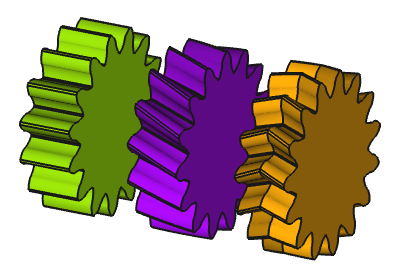FCGear Zykloidenzahnrad
|
|
| Menüeintrag |
|---|
| Gear → Cycloid Gear |
| Arbeitsbereich |
| FCGear |
| Standardtastenkürzel |
| None |
| Eingeführt in Version |
| v0.16 |
| Siehe auch |
| FCGear Evolventenzahnrad |
Beschreibung
Cycloidal gears are very sensitive to an inaccurate adjustment of the centre distance, which then leads to a change in the transmission ratio. For these reasons, cycloidal gears are hardly found in mechanical engineering but are only used in special cases such as in the watch industry, for roots type blowers or for the drive of gear racks.
Von links nach rechts: Stirnräder mit Geradverzahnung, Schrägverzahnung, Pfeilverzahnung
Anwendung
- Zum Arbeitsbereich
FCGear wechseln.
- Es gibt mehrere Möglichkeiten den Befehl aufzurufen:
- Die Schaltfläche
Cycloid Gear drücken.
- Den Menüeintrag Gear →
Cycloid Gear auswählen.
- Die Schaltfläche
- Die Einstellungen den geforderten Randbedingungen entsprechend ändern (siehe Eigenschaften).
Eigenschaften
Daten
Ein FCGear-CycloidGear-Objekt wird von einem Part-Formelement abgeleitet und erbt alle seine Eigenschaften. Außerdem hat es die folgenden zusätzlichen Eigenschaften:
accuracy
- Datennumpoints (
Integer): Default is15. Change of the involute profile. Changing the value can lead to unexpected results.
base
- Datenheight (
Length): Default is5 mm. Value of the gear width. - Datenmodule (
Length): Default is1 mm. Module is the ratio of the reference diameter of the gear divided by the number of teeth (see Notes). - Datenteeth (
Integer): Default is15. Number of teeth.
computed
- Datenangular_backlash (
Angle): (read-only) - Datendw (
Length): (read-only) Working pitch diameter.
cycloid
- Dateninner_diameter (
Float): (read-only) Diameter of the rolling circle of hypocycloid, normalized by the Datenmodule (see Notes). - Datenouter_diameter (
Float): Default is7.5. Diameter of the rolling circle of epicycloid, normalized by the Datenmodule (see Notes).
fillets
- Datenhead_fillet (
Float): Default is0 mm. - Datenroot_fillet (
Float): Default is0 mm.
helical
- Datenbeta (
Angle): Default is0 °. With the helix angle β a helical gear is created – positive value → rotation direction right, negative value → rotation direction left. - Datendouble_helix (
Bool): Default isfalse,truecreates a double helix gear (see Notes).
tolerance
- Datenbacklash (
Length): Default is0. Backlash, also called lash or play, is the distance between the teeth at a gear pair.
- Datenclearance (
Float): Default is0.25(see Notes). - Datenhead (
Float): Default is0. Additional length of the tip of the teeth, normalized by the Datenmodule.
version
- Datenversion/de (
String):
Hinweise
- Cycloidal gears must always be specially matched to each other and can generally not be exchanged at will: In a gear pair, the value of inner_diameter on one gear must equal the outer_diameter on the other, and vice versa. See also the information in Properties cycloid parameter view below.
- clearance: At a gear pair, clearance is the distance between the tooth tip of the first gear and the tooth root of the second gear.
- double_helix: To use the double helical gearing the helix angle β (beta) for the helical gearing must first be entered.
- module: Using ISO (International Organization for Standardization) guidelines, Module size is designated as the unit representing gear tooth-sizes. Module (m): m = 1 (p = 3.1416), m = 2 (p = 6.2832), m = 4 (p = 12.566). If you multiply Module by Pi, you can obtain Pitch (p). Pitch is the distance between corresponding points on adjacent teeth.
Special cases
Straight line as hypocycloid
To obtain a straight line, directly towards the center, as hypocycloid, use the following expression for the Dateninner_diameter: teeth / 2. Such a tooth form is often found in historical clockworks and thus called "clock toothing". A larger Datenclearance makes the effect even more visible.
Full hypocycloid/epicycloid as tooth
To obtain a gear made of complete hypocycloid and epicycloid curves use the following expressions:
- Dateninner_diameter:
0.5 + 1e-6 - Datenouter_diameter:
inner_diameter - Datenclearance:
(-1 + inner_diameter/1mm) * 2 - Datenhead:
(-1 + outer_diameter/1mm) * 2
The reference diameter is d = m * z, with m being the Datenmodule and z being the Datenteeth.
For a complete hypocycloid, the rolling diameter has to be d_i = d / (z*2) = m*z / (z*2). And if we now normalize this by the module, we get d_in = m*z / (z*2) / m = 1 / 2. The additional explicit tolerance value (1e-6 in the expression above) is required to overcome coincidence issues.
Now the cycloids' rolling circle diameters have to match the gear's addedum/dedendum. The addendum, i.e. the tooth length above the reference circle, is 1 + Datenhead. The dedendum, i.e. the tooth length below the reference circle, is 1 + Datenclearance. Both are normalized by the module, thus we need a head/clearance value of 1 - d_in. The additional / 1mm and * 2 are required to overcome shortcomings already fixed in the development version of the FCGear Workbench, but porting those fixes back to the stable version may break existing models.
Such "gears" allow the the number of teeth to be as low as two and are used as rotary vanes in pumps or compressors (cf. Roots-type Supercharger).
Infinitely large epicycloid
If the radius of the epicycloid's rolling circle becomes infinitely large, it becomes a rolling straight line. Such a degenerated epicycloid is called involute. Gears with such a tooth form are handled by the involute gear command. It is by far the most common tooth form Today.
Nützliche Formeln
Siehe FCGear Evolventenzahnrad.
Eigenschaften Zykloidenparameter Ansicht

